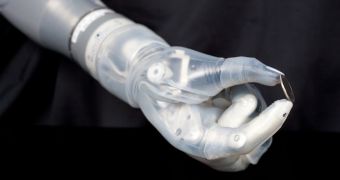So far, prosthetics have fallen short of truly reproducing the whole functionality of whatever limb they are replacing, but a breakthrough has been made, one that the US Food and Drug Administration has just approved.
The main problem with mechanized and/or electric, robotic legs and arms has so far been the inability to process more than one command at once.
So while you could, in theory, lift your prosthetic arm, set it near a glass of water and curl your “fingers” around the glass, it doesn't exactly happen quickly.
The new “Luke” arm or DEKA Arm System, from Segway inventor Dean Kamen, can process more than one command at once.
It is this breakthrough that allows amputees a range of movements almost as good as that of the real, flesh and blood thing. Well, as far as functionality goes. Ease of use is still an issue, since the grips are partially controlled by your feet.
It's no wonder that the “Luke” was approved by the FDA faster than almost every other prosthetic in history (it was fast-tracked in the “de noco” classification process).
Even so, however, it took eight full years to go from an idea on paper to an actual arm that replaces everything cut from below the shoulder.
Unlike the contraptions before it, the DEKA Arm System doesn't just use a metal hook to hang off the shoulder joint. It is made to look and feel like a natural limb, in addition to working like one.
Besides, all the different functions needed good hardware, and a place to store a good battery, so the space is being put to good use.
For those who want the specifics, Luke can recognize 10 specific movements and use one of six grips at any given time.
Next Step Bionics & Prosthetics will handle mass production, though it's unclear how much patients will have to pay. Probably a lot, though we're hoping for hundreds of thousands instead of anything in the range of tens of thousands of dollars.
We aren't holding out too much hope, however, knowing that the research and development process cost DARPA $40 million / €30 million.
Then again, some may feel that no price is too high in exchange for regaining the ability to use keys and locks, pick up eggs without breaking them, or removing paper from an envelope (albeit still with some awkwardness).
All thanks to electromyogram (EMG) sensors controlled by how wearers activate their muscles near the spot where the prosthetic is attached (or on their feet). The new hand can even hold a coin by the edges.

 14 DAY TRIAL //
14 DAY TRIAL // 